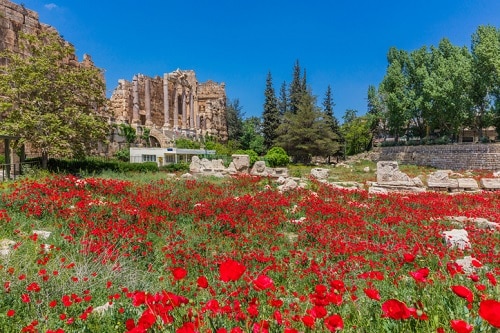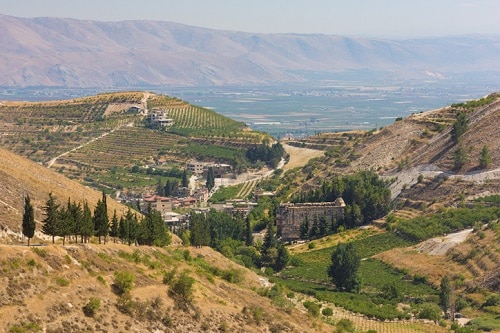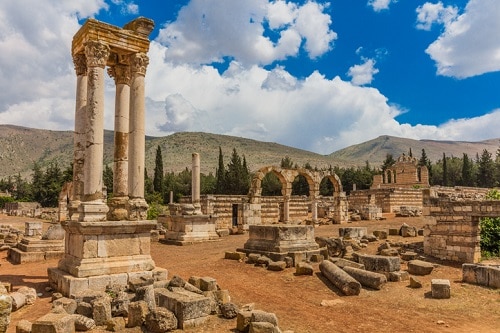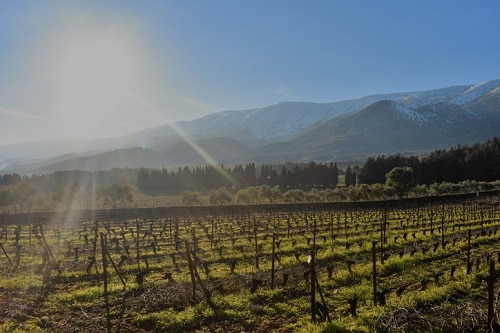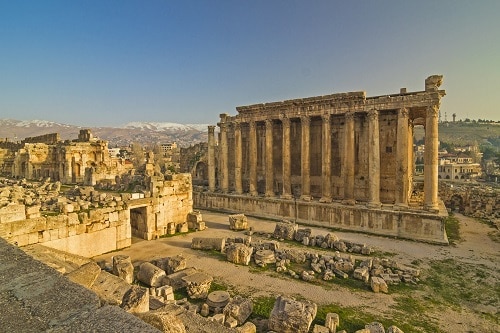Discover the Wine Regions of Lebanon
Last Updated on October 29, 2023.
History of Lebanese Wine
Lebanese wine production has a long but tumultuous history. There is evidence of winemaking here that goes as far back as the biblical period. In the bible, the prophet Hosea urged his people to return to God so that, “they shall blossom like the vine; their fame shall be like the wine of Lebanon.” (Hosea 14.7)
The location of the Temple of Bacchus, dedicated to the Roman God of Wine, provides further evidence. It’s located in Lebanon’s Bekaa Valley, and is believed to have been built between 150-250 AD.
Years of war and occupation stifled wine production. Winemaking was banned except for religious purposes when Lebanon was part of the Ottoman Empire. Wars in the 20th century – both international and civil – also proved disruptive.
Today, Lebanon’s wine industry is tiny in the global context. Its annual 10 million bottle production could be drunk in just four hours at current rates of consumption around the world. However, over the last two decades, it has been increasing steadily. Twenty years ago Lebanon was home to just four wineries. Today, the number stands at 56.
The Terroir of Lebanon’s Wine Regions
Generally speaking, Lebanon is a warm, dry and sunny country. Its quality grapes come from high-altitude areas where the temperatures are cooler, especially at night.
The Bekaa Valley — approximately 30km east of Beirut — is the most important area for grape growing. Most of the vines here are plated above 1,000m. Low humidity throughout the summer means that minimal chemical spraying is needed on the vines grown in the area.
The Batroun region in northern Lebanon has also emerged as a producer of quality wines from a multitude of grape varieties and terroirs.
Lebanese Wine Styles
Around 30 different varieties are known to be grown in Lebanon. Cinsault and Cariginan, along with Mourvèdre and Grenache, have long been planted here. More recently they have been joined by significant plantings of international varieties such as Cabernet Sauvignon, Merlot, Syrah, Chardonnay and Cabernet Franc.
Wines are made in a variety of styles. Its perfumed, exotically spicy and full-bodied reds are what the country is known for.
Lebanese Wineries To Know, Taste and Visit
Chateau Musar is Lebanon’s best-known and arguably most important producer. It was founded by Gaston Hochar, an admirer of Bordeaux in the 1930s but brought to fame by his son and former winemaker, Serge Hochar. Serge famously continued to make wine during the Lebanese civil war (1975-1990) while others stopped.
Chateau Musar makes red, rosé and white wines. Musar’s reds which they are most famous for consist of an unusual blend of Cabernet Sauvignon with Cinsault and Carignan.
The wines are often released onto the market after many years of aging, making it relatively easy to source old bottles.
Winetraveler Tip: Travelers through London are encouraged to check out the duty-free stores of Gatwick Airport for mature Musar.
Chateau Ksara is the country’s biggest winery, producing around four out of every ten bottles that come out of Lebanon. It was first farmed in 1857 by Jesuit Monks. Today, it makes 16 different labels of dry and sweet white, red, and rosé wine.
One of our favorite producers crafting Syrah and Syrah-based blends with unmatched levels of complexity is Atibaia. They’re a boutique producer within the Batroun region located in the mountains of Smar Jbeil.
Newer producers are also making their marks on the Lebanese wine market. In December 2019, Winetraveler met with the Maher Harb of Sept and Joe Saade of Terre Joie at a presentation at the Florida Wine Academy.
Terre Joie’s wines – all red and rosé – are made organically. Uniquely, the vineyards span three tectonic plates. Saade aims for (and achieves) elegance in the wines by planting only at high altitudes of 1,000-1,400m and using only free-run juice.
Maher Harb planted Sept’s first hectare of vines in his father’s village in 2012, and now works with vineyards across Lebanon to source grapes. His interesting Merwah (indigenous white) wine grapes are sourced from a 120-year-old vineyard where the vines climb on trees. Until Harb “discovered” it, the grapes were eaten, not fermented. It’s now used to produce around 700 bottles of characterful white wine.
Interested in learning more about Lebanese wines and various ways to go about visiting the country? Download the free Winetraveler App here and search “Lebanon.”
Written By Sarah Phillips
Sarah Phillips is a Miami-based marketer and wine educator. After spending nearly five years working in the London wine trade, she relocated to Miami in January 2019. Sarah has her WSET Diploma (Level 4 Certified) and teaches classes with a focus on the wines of France, Spain, Portugal and Italy at the Florida Wine Academy.
